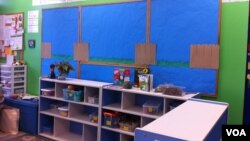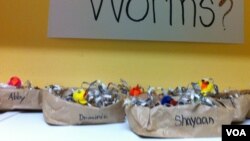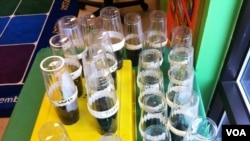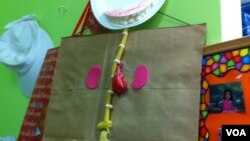POTOMAC, MD —
The world celebrates Earth Day every year on April 22. But one private school in the suburban Washington city of Potomac, Maryland, commemorates Earth Day every day. There, children up to six years of age learn about the environment and take action to show their love of the Earth.
A child's world is the world of playing. They love being outside in the open air, chasing each other, sliding or playing on a seesaw.
At St. James school in Potomac, Maryland, children between the ages of two and six add to their world full of fun by observing worms and picking up trash in the school yard. Inside their classrooms, they conserve water and electricity, re-use and recycle, and every spring, cultivate soil to plant flowers and vegetables in the school's garden.
Rebecca Boker teaches the children the importance of preserving the earth.
“If children learn it early on when they are younger, it will become a part of their daily lives," she explained. "Not something that they have to think twice about. It should be something that every one does. That way it becomes an integral part of their daily routines.”
"What happens if the water has chemicals in it?" Boker asked her students.
"Then the plant wouldn’t grow," one child suggested.
"It would die," another child offered.
"It could go down and then go back into the ground," a third child theorized.
"Right, it may grow for a little while," Boker told the children, "but then the plants are going to know that it’s not clean water, just like other plants and animals in our earth need clean water, don’t they?"
Boker said at St. James, every day is Earth Day. She pointed to books in all the classrooms, and rows and rows of books in the school library. Most of the books contain materials that encourage children to do something to preserve the environment, to protect the Earth.
“This is their home," Boker stressed. "You are visitors in their home. So it is your job to respect their home just like you want others to respect your home and treat your home nicely.”
At St. James, children are invited to observe the growth of plants from seeds to sprouts in used plastic cups kept in the classroom, then to grow them in the garden. They also observe the life cycle of butterflies and insects, and learn about rain and sea life.
Other materials about nature and its effects on human life are available around the school: a special rain garden, beds of flowers and vegetables, a compost bucket, and worms. In each class, a lot of materials are made from re-using unwanted things or recycling waste. For example, an area rug in the middle of every classroom is made of recycled tires.
“Every day we remind them always … that goes to the recycling," explained Courtney Mollman, another teacher at the school. "And then on Earth Day we do huge garden clean-up, and we’ve been talking to them about what that means.”
There also is a bathroom in every classroom. Mollman explained the important role of these half-baths in directing children to preserve the environment, to familiarize them with conserving water and electricity, and to be smart in using toilet paper.
Boker said the children "totally understand" the message they are trying to convey.
Even kids as young as 2, she said, can see that there are blue bins for recycling, or they are not going to break toys, so that they won't end up in a big trash bag.
"Imagine how fish feel when they are swimming around and see your trash floating around at the beach? Would that be fun for them?" Boker asked her students.
"It’s gonna block their way," one child offered.
"It also might have chemicals on it. Then what happens?" Boker asked.
"They’ll die," the class responded in unison.
"It’s bad for the Earth," added a student.
Earth Day, observed every year since 1970, is designed to increase awareness of and appreciation for our planet.
A child's world is the world of playing. They love being outside in the open air, chasing each other, sliding or playing on a seesaw.
At St. James school in Potomac, Maryland, children between the ages of two and six add to their world full of fun by observing worms and picking up trash in the school yard. Inside their classrooms, they conserve water and electricity, re-use and recycle, and every spring, cultivate soil to plant flowers and vegetables in the school's garden.
Rebecca Boker teaches the children the importance of preserving the earth.
“If children learn it early on when they are younger, it will become a part of their daily lives," she explained. "Not something that they have to think twice about. It should be something that every one does. That way it becomes an integral part of their daily routines.”
"What happens if the water has chemicals in it?" Boker asked her students.
"Then the plant wouldn’t grow," one child suggested.
"It would die," another child offered.
"It could go down and then go back into the ground," a third child theorized.
"Right, it may grow for a little while," Boker told the children, "but then the plants are going to know that it’s not clean water, just like other plants and animals in our earth need clean water, don’t they?"
Boker said at St. James, every day is Earth Day. She pointed to books in all the classrooms, and rows and rows of books in the school library. Most of the books contain materials that encourage children to do something to preserve the environment, to protect the Earth.
“This is their home," Boker stressed. "You are visitors in their home. So it is your job to respect their home just like you want others to respect your home and treat your home nicely.”
At St. James, children are invited to observe the growth of plants from seeds to sprouts in used plastic cups kept in the classroom, then to grow them in the garden. They also observe the life cycle of butterflies and insects, and learn about rain and sea life.
Other materials about nature and its effects on human life are available around the school: a special rain garden, beds of flowers and vegetables, a compost bucket, and worms. In each class, a lot of materials are made from re-using unwanted things or recycling waste. For example, an area rug in the middle of every classroom is made of recycled tires.
“Every day we remind them always … that goes to the recycling," explained Courtney Mollman, another teacher at the school. "And then on Earth Day we do huge garden clean-up, and we’ve been talking to them about what that means.”
There also is a bathroom in every classroom. Mollman explained the important role of these half-baths in directing children to preserve the environment, to familiarize them with conserving water and electricity, and to be smart in using toilet paper.
Boker said the children "totally understand" the message they are trying to convey.
Even kids as young as 2, she said, can see that there are blue bins for recycling, or they are not going to break toys, so that they won't end up in a big trash bag.
"Imagine how fish feel when they are swimming around and see your trash floating around at the beach? Would that be fun for them?" Boker asked her students.
"It’s gonna block their way," one child offered.
"It also might have chemicals on it. Then what happens?" Boker asked.
"They’ll die," the class responded in unison.
"It’s bad for the Earth," added a student.
Earth Day, observed every year since 1970, is designed to increase awareness of and appreciation for our planet.








